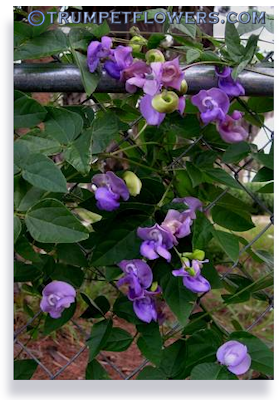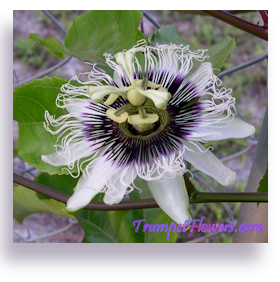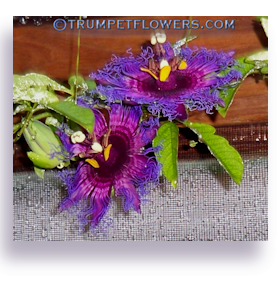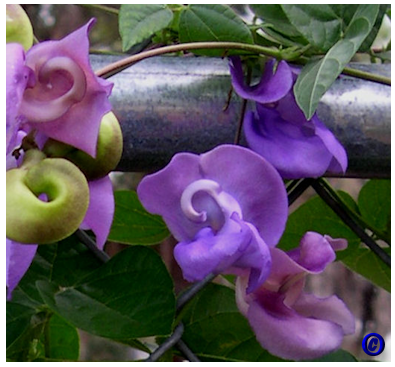 Vigna is an interesting group of bean plants, some that are cultivated for their lovely and unusual flowers. The favorite are the Scarlet runner bean, or phaseolus coccineus and Purple snail vine, or Phaseolus giganteus. Sometimes called the Corkscrew vine too, because of the winding flowers, the name 'Corkscrew vine' is more appropriately used to talk about Vigna caracalla, which is multicolored white with lavender and pink tones all in one lovely little flower. Incidentally, lima beans are also phaseolus.
Vigna is an interesting group of bean plants, some that are cultivated for their lovely and unusual flowers. The favorite are the Scarlet runner bean, or phaseolus coccineus and Purple snail vine, or Phaseolus giganteus. Sometimes called the Corkscrew vine too, because of the winding flowers, the name 'Corkscrew vine' is more appropriately used to talk about Vigna caracalla, which is multicolored white with lavender and pink tones all in one lovely little flower. Incidentally, lima beans are also phaseolus.
Vigna Phaseolus giganteous, or Purple Snail vines in this case, are tender growers, not like some of their cousins, who can withstand temperate climates, so if grown up north, they are grown as annuals. In zones 9, 10 and above, they can withstand the light frosts of zone 9, and although the plant will die to the ground, it will spring back from the roots when the temperatures begin to rise and one resumes watering.
Purple Snail vines are greedy feeders, make sure to fertilize them once a week, with 1/2 strength fertilizer, or twice a month, full strength. A regular, everyday MiracleGro fertilizer type is fine.
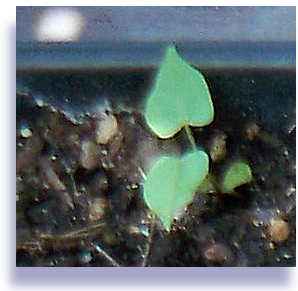 Purple Snail vines do not like cold and wet for too long of a time. If their soil is wet, and it stays cold too long, the plants will begin to rot. Do not overwater, instead wait for the top inch or so of the soil to slightly dry before watering them. Also make sure the soil has good drainage.
Purple Snail vines do not like cold and wet for too long of a time. If their soil is wet, and it stays cold too long, the plants will begin to rot. Do not overwater, instead wait for the top inch or so of the soil to slightly dry before watering them. Also make sure the soil has good drainage.
Just this summer, because it has been so wet, I have found that Slime Mold has been attracted to onepart of the vine that is under some trees, where it stays damp and has little sunlight. I looked up information on it, and it seems incurable. All one can do is wait out it's life cycle. The sources also mention trying to add more areation to the affected spot.
Snail vine germinates easily from seed. Seed viability is 3 to 4 years, before it is no longer fresh enough to sprout. Sprouts appear within 7 to 20 days, and are best planted in moderate temperatures, between 65° and 78°, for best germination rates. I just recently sprouted up a bunch of purple snail vine seed that is just over a year old. It started appearing in 7 days.
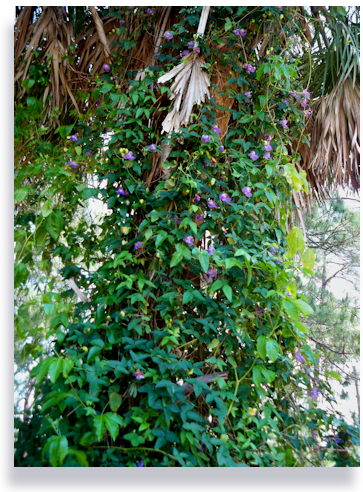 ◄ Purple Snail vine can be invasive if left to do as it pleases, and has no threat of frost. Here it is over 30 feet up a palm, where it has come off of my fence to sprawl the tree. But it is beautiful just like this, in my opinion. The lime green leaves are of passiflora edulis, mixed in with it.
◄ Purple Snail vine can be invasive if left to do as it pleases, and has no threat of frost. Here it is over 30 feet up a palm, where it has come off of my fence to sprawl the tree. But it is beautiful just like this, in my opinion. The lime green leaves are of passiflora edulis, mixed in with it.
Vigna Phaseolus giganteus is highly sought after, and is a twining vine that does well in a hanging basket. They easily handle full sun. For more flowers, be sure to remember to fertilize them. If you do place it in a hanging basket, be ready to keep it pruned. It is a fast grower and will easily take over a patio screen if left to it's own means.
Give them a 1/2 sand, 1/4 loam and compost, 1/4 peat type soil. I just sprinkle the snail vine seeds right on the surface of the already soil filled pots, without covering them. The watering they receive will cover them ever so lightly, and they all sprout very well like this.
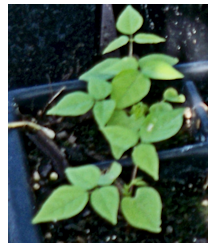 Down here in zone 10A, we haven't had a frost in years. The sail vines I started from seeds 4 years ago are gigantic, sprawling over 40 or so feet of 5 foot chain link fence. The base of the plants are at least 2 inches in diameter, with stems about 1 inch. It also becomes quite woody, so this perrenial vine is tough if in right climate. I love that it does not simply run for the top of the fence and then only grow there, leaving the side of the fence bare. Instead, it fills in the entire height of the fence, making the snail vine an excellent privacy screen.
Down here in zone 10A, we haven't had a frost in years. The sail vines I started from seeds 4 years ago are gigantic, sprawling over 40 or so feet of 5 foot chain link fence. The base of the plants are at least 2 inches in diameter, with stems about 1 inch. It also becomes quite woody, so this perrenial vine is tough if in right climate. I love that it does not simply run for the top of the fence and then only grow there, leaving the side of the fence bare. Instead, it fills in the entire height of the fence, making the snail vine an excellent privacy screen.
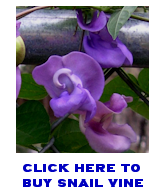 Hundreds of flowers are covering the snail vine right now, (March 2013) as it rained the night before. They seem to bloom so much stronger after the rains of spring arrive. Snail vine will bloom throughout the year here in zone 10A, but I tend to see the most bloom set in early spring through May. After that, purple snail vine begins to set the small pea like pods that you can harvest to grow more. Ants tend to pollinate this, as it is hard for the butterflies (I think impossible) to get their probiscus into the tightly wrapped curl of the flowers. The flowers themselves are about 1 and a half to 2 inches wide, and the same in height. Very pretty indeed.
Hundreds of flowers are covering the snail vine right now, (March 2013) as it rained the night before. They seem to bloom so much stronger after the rains of spring arrive. Snail vine will bloom throughout the year here in zone 10A, but I tend to see the most bloom set in early spring through May. After that, purple snail vine begins to set the small pea like pods that you can harvest to grow more. Ants tend to pollinate this, as it is hard for the butterflies (I think impossible) to get their probiscus into the tightly wrapped curl of the flowers. The flowers themselves are about 1 and a half to 2 inches wide, and the same in height. Very pretty indeed.
Snail Vine will develop a paler, almost white flower if you under water or under fertilize it. The plant is quite resilient though, and will bounce back as soon as you start taking good care of it again.
 If you'd like to learn more about the lovely Corkscrew vine, click here.
If you'd like to learn more about the lovely Corkscrew vine, click here.
If you'd like to grow your own snail vine, you can buy the plant or seeds here: Purple Snail Vines For Sale. If you want to buy the Corkscrew vine, click here.Corkscrew Vine for sale, Vigna caracalla for sale
Tags: purple snail vine, purple snail vine, vigna, Vigna Phaseolus giganteus, phaseolus, snail vine, purple snail vine, corkscrew vine, privacy screen, grow snail vine from seed, grow vigna phaseolus from seed, privacy fence with vine,

